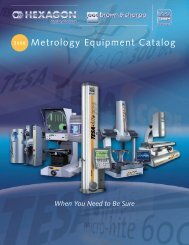shaping the future of metrology - Brown & Sharpe
shaping the future of metrology - Brown & Sharpe
shaping the future of metrology - Brown & Sharpe
Create successful ePaper yourself
Turn your PDF publications into a flip-book with our unique Google optimized e-Paper software.
Multifunction CMM systems<br />
speed up <strong>the</strong> design <strong>of</strong><br />
free surface car bodies<br />
The design and production <strong>of</strong> car<br />
bodies currently rely on 3D surface<br />
models <strong>of</strong> <strong>the</strong> parts.These models<br />
are developed ei<strong>the</strong>r ma<strong>the</strong>matically<br />
on CAD workstations, physically in a<br />
stylist’s studio, or in a technician’s lab-<br />
oratory. Expensive iterations on models<br />
are always needed to refine part surfaces<br />
and transform <strong>the</strong> stylist’s concept into<br />
an efficiently producible product.<br />
38 mfg. Shaping <strong>the</strong> Future <strong>of</strong> Metrology<br />
Left: Laser scanning<br />
probes can be fitted to<br />
CMMs, giving <strong>the</strong>m <strong>the</strong><br />
ability to digitize complex<br />
shapes for fast and<br />
accurate model making.<br />
Above: The light milling<br />
function available on a<br />
<strong>Brown</strong> & <strong>Sharpe</strong> DEA<br />
gantry CMM transforms<br />
it into a machine tool for<br />
constructing surfaces on<br />
s<strong>of</strong>t materials.<br />
That is <strong>the</strong> case <strong>of</strong><br />
styling driven designs,<br />
where <strong>the</strong> part<br />
shape is determined by<br />
a stylist working in clay<br />
or plastics; <strong>of</strong> experiment<br />
driven designs, where a prototype is<br />
modified by hand by engineers that tune<br />
its functional efficiency; and <strong>of</strong> manufacturing-driven<br />
part redesign, where <strong>the</strong> final<br />
shape <strong>of</strong> <strong>the</strong> component is deter-<br />
mined by changes made to its tooling<br />
with <strong>the</strong> objective <strong>of</strong> improving part<br />
quality or production efficiency. In all<br />
cases, a closer interaction between stylist<br />
and model maker can help save<br />
weeks <strong>of</strong> development time.<br />
Gantry CMMs, equipped with suitable<br />
s<strong>of</strong>tware and accessories, are excellent<br />
tools to support style model design<br />
activities and production engineering<br />
operations, as well as to improve die and<br />
mold design and manufacturing for large<br />
contoured parts, such as car bodies and<br />
subassemblies.The huge size <strong>of</strong> <strong>the</strong>ir<br />
measuring envelopes, plus <strong>the</strong>ir open<br />
construction, allows easy handling <strong>of</strong><br />
very large workpieces. In addition, owing<br />
to <strong>the</strong> rigidity <strong>of</strong> <strong>the</strong>ir structure, <strong>the</strong>se<br />
machines can also hold large head and<br />
probe assemblies, as well as powerful 3<br />
and 5-axis milling heads, without compromising<br />
<strong>the</strong>ir high measuring accuracy.<br />
Scanning S<strong>of</strong>tware<br />
Adds Versatility<br />
by Marco Manganelli<br />
Gantry machines can be equipped<br />
with easy-to-use continuous path scanning<br />
s<strong>of</strong>tware that supports tactile and<br />
laser scanning probes for fast and accurate<br />
model digitizing, and for producing<br />
part programs to control NC milling machines.The<br />
system can efficiently operate<br />
With <strong>the</strong>ir ability to quickly capture dimensional data from 3D surfaces, gantry CMMs like this <strong>Brown</strong> & <strong>Sharpe</strong> DEA<br />
DELTA give automobile manufacturers <strong>the</strong> flexibility to make rapid design changes.<br />
unattended. Automatic scanning routines<br />
react to surface changes, repositioning<br />
<strong>the</strong> machine or head to keep <strong>the</strong> probe in<br />
contact with <strong>the</strong> workpiece, even with<br />
complex contoured parts. Computer compensation<br />
<strong>of</strong> <strong>the</strong> machine geometry and<br />
probe deflection guarantees maximum<br />
scanning accuracy.<br />
The surface data points generated by<br />
<strong>the</strong> system can be directly imported into<br />
a CAD workstation to create a ma<strong>the</strong>matical<br />
representation <strong>of</strong> <strong>the</strong> part geometry.<br />
This technology is extremely useful when<br />
an old part is available, but no CAD data<br />
is available, or when manufactured parts<br />
must be created from physical prototypes.<br />
The surface data points may also be postprocessed<br />
by <strong>the</strong> CMM computer to produce<br />
a cutter path for all machining<br />
passes, from rough cutting to finishing,<br />
for efficient model copying. Easy-to-use<br />
reverse engineering functions simplify<br />
<strong>the</strong> process <strong>of</strong> modifying <strong>the</strong> style model<br />
after engineering or manufacturing<br />
changes on <strong>the</strong> final part.These functions<br />
allow <strong>the</strong> generation <strong>of</strong> CAD/CAM data<br />
directly from <strong>the</strong> part scanning files. In a<br />
typical reverse engineering application, a<br />
model <strong>of</strong> a part may have been<br />
initially machined from a<br />
CAD file and later modi-<br />
fied by hand to meet<br />
functional or manufacturing<br />
requirements. By<br />
scanning <strong>the</strong> modified<br />
areas <strong>of</strong> <strong>the</strong> model, <strong>the</strong><br />
operator can create useful<br />
data to embody <strong>the</strong>se<br />
changes in <strong>the</strong> original part<br />
database. Direct model copying functions<br />
for die and mold making are supported<br />
by advanced s<strong>of</strong>tware features that<br />
allow process optimization, saving time<br />
and money.These functions include cutter<br />
radius compensation, automatic<br />
model alignment, and male/female conversion.<br />
A powerful light milling function<br />
transforms <strong>the</strong> gantry CMM into an NC<br />
milling machine to build complex sur-<br />
Gantry CMMs…are<br />
excellent tools to<br />
support style model<br />
design activities…<br />
faces on s<strong>of</strong>t materials, such as clay, polystyrene,<br />
epoxy, and aluminum.This advanced<br />
technology, combined with <strong>the</strong><br />
scanning capabilities, provides a<br />
global solution to styling model<br />
design and development, as<br />
well as die and mold making.The<br />
light milling function<br />
proves its validity in<br />
<strong>the</strong> creation <strong>of</strong> 3D physical<br />
models and prototypes<br />
from CAD data files to support<br />
<strong>the</strong> stylist’s work and to<br />
validate die addendums and modifications<br />
prior to cutting metal, thus eliminating<br />
<strong>the</strong> need for expensive iterations<br />
on prototypes.<br />
Reducing Design Time<br />
at Peugeot<br />
The Advanced Styling Department <strong>of</strong><br />
PSA-Peugeot Citröen, a major European<br />
car manufacturer, has approached <strong>the</strong><br />
problem <strong>of</strong> reducing <strong>the</strong> art-to-part cycle<br />
mfg. The <strong>Brown</strong> & <strong>Sharpe</strong> Publication <strong>of</strong> Precision Manufacturing<br />
39



